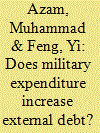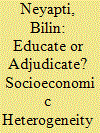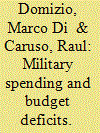|
|
|
Sort Order |
|
|
|
Items / Page
|
|
|
|
|
|
|
| Srl | Item |
| 1 |
ID:
155300


|
|
|
|
|
| Summary/Abstract |
This paper develops a panel smooth transition vector autoregressive model to investigate the economic growth–defense causality. This model simultaneously resolves the estimation problems of endogeneity, heterogeneity, and nonlinearity. Empirical results support that the causality is bidirectional, nonlinear, time- and country-varying. Economic growth has a negative impact on military spending and vice versa. The larger the HDI, the smaller the negative causality. Evidently, the increase in the level of country development can reduce the negative impact of military outlays on economic growth. Reducing the ratio of military spending to GDP is beneficial for countries with low HDI scores; however, moderately increasing the share of military expenditure is favorable for countries with extremely high HDI scores. Policy authority needs to set optimal education, health, and economic development shares of GDP for purchasing a maximum economic growth rate.
|
|
|
|
|
|
|
|
|
|
|
|
|
|
|
|
| 2 |
ID:
155299


|
|
|
|
|
| Summary/Abstract |
This article empirically explores the effect of military spending on external debt, using a sample of ten Asian countries over the years from 1990 to 2011. The Hausman’s test suggests that the random-effects model is preferable; however, both random-effects and fixed-effects models are used in this research. The empirical results show that the effect of military spending on external debt is positive, while the effects of foreign exchange reserves and of economic growth on external debt are negative. For developing countries caught in security dilemma, military expenditure often requires an increase in external debt, which may affect economic development negatively.
|
|
|
|
|
|
|
|
|
|
|
|
|
|
|
|
| 3 |
ID:
155296


|
|
|
|
|
| Summary/Abstract |
I present a formal framework to explore the welfare and distributional effects of a government’s optimal choice over two types of public spending in a closed economy: domestic security (DS) and investment in social capital (SC). Production is characterized as a function of social and physical capital stocks that both vary across the regions. DS stands for total factor productivity, while SC stands for human capital and civic cooperativeness combined. SC accumulates via public spending on universal primary education, cultural, and civic events and such, and is exposed to regional spillover effects. Numerical simulations of the static solution of the government’s welfare maximization problem reveal that the optimal rate of spending on SC (m*) is negatively related with the income share of physical capital, SC spillovers and fiscal decentralization. Simulations also show that SC homogeneity is positively associated with both the level and equitability of aggregate income. The maximum attainable levels of income, welfare and social cohesion and the most equitable incomes are all observed to realize at some intermediate range of m* values. In case DS augments SC, however, social cohesion improves and welfare declines monotonously in m*.
|
|
|
|
|
|
|
|
|
|
|
|
|
|
|
|
| 4 |
ID:
155301


|
|
|
|
|
| Summary/Abstract |
Dunne, Smith, and Willenbockel (2005) argue that the mainstream growth literature has not found military spending to be a significant determinant of economic growth, yet much of the defense economics literature has noted significant effects. This paper revisits this issue by using a DSGE-VAR approach, combining both theoretical and empirical methods. We present that the DSGE approach (estimated with the Bayesian technique) and the Bayesian VAR with the Minnesota Prior both lead to worse in-sample fit than our proposed DSGE-VAR framework. The DSGE-VAR approach reveals that a positive military spending shock boosts the U.S. economy, increasing per capita real GDP growth, consumption, inflation and interest rate. Our results are robust to alternative model specifications. Future investigations such as exploring an optimal military spending policy could adopt the approach in this paper to determine the best model – empirical, theoretical, or a combination of the two.
|
|
|
|
|
|
|
|
|
|
|
|
|
|
|
|
| 5 |
ID:
155298


|
|
|
|
|
| Summary/Abstract |
The aim of this paper is to study the relationship between military spending and sovereign debt in a panel of 13 European countries. In particular, under the assumption of the interdependence of military spending between US and European countries, we analyse whether US military spending affected European sovereign debt in the period 1988–2013. The empirical estimation is based on different steps: (i) a unit root test; (ii) an Arellano–Bond panel estimation and a linear fixed effect model; and (iii) a FMOLS estimation to highlight the long run relationship between debt and relevant variables. General results highlight that debt burden of European countries is: (1) positively associated with US military burden and (2) negatively associated with average military burden of other European countries.
|
|
|
|
|
|
|
|
|
|
|
|
|
|
|
|
| 6 |
ID:
155302


|
|
|
|
|
| Summary/Abstract |
This empirical note re-examines the causal linkages between military expenditures and economic growth for the BRICS countries (Brazil, Russia, India, China, and South Africa) and that for the USA during the period 1988–2012. Results of Granger causality tests show that military expenditures influence economic growth in the USA, economic growth influences military expenditures in both Brazil and India, a feedback between military expenditures and economic growth in Russia, and no causal relation exists between military expenditures and economic growth in China and South Africa. The findings of this study can provide important policy implications for the BRICS countries and also for the USA.
|
|
|
|
|
|
|
|
|
|
|
|
|
|
|
|
| 7 |
ID:
155297


|
|
|
|
|
| Summary/Abstract |
The study examines the effect of noncognitive skills on early career choices among young job seekers. Specifically, we analyze the influence of personality traits on the decision by military applicants either to choose the military or a civilian career option. We use a unique micro-level data-set of applicants to the US Navy and exploit the fact that many individuals who initially apply for military jobs eventually choose civilian careers instead. In this institutional setting, job candidates use new information to update their beliefs about the military job match. Personality traits are viewed as productive abilities that influence applicants’ expectations about the economic return to the job and occupational training offered by the Navy. The study finds that many of the 15 lower order personality facets associated with the Big Five traits are predictive of applicants’ job choices and provides suggestive evidence of a link between personality traits, job match expectations, and career choice.
|
|
|
|
|
|
|
|
|
|
|
|
|
|
|
|
|
|
|
|
|